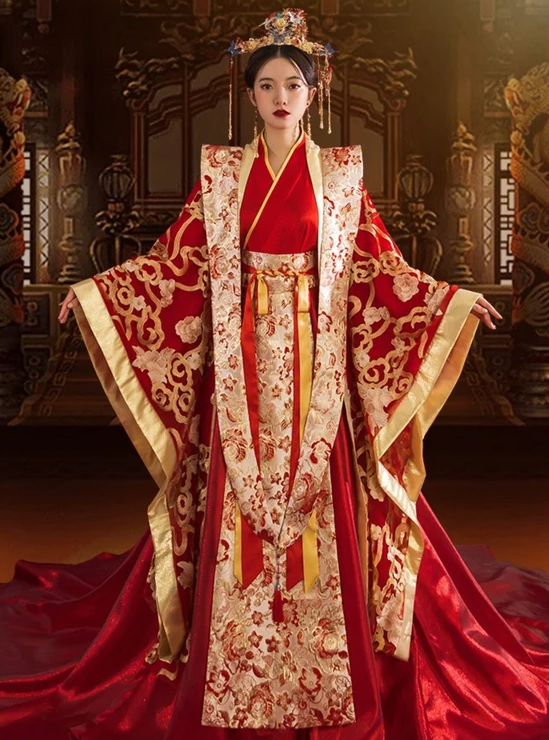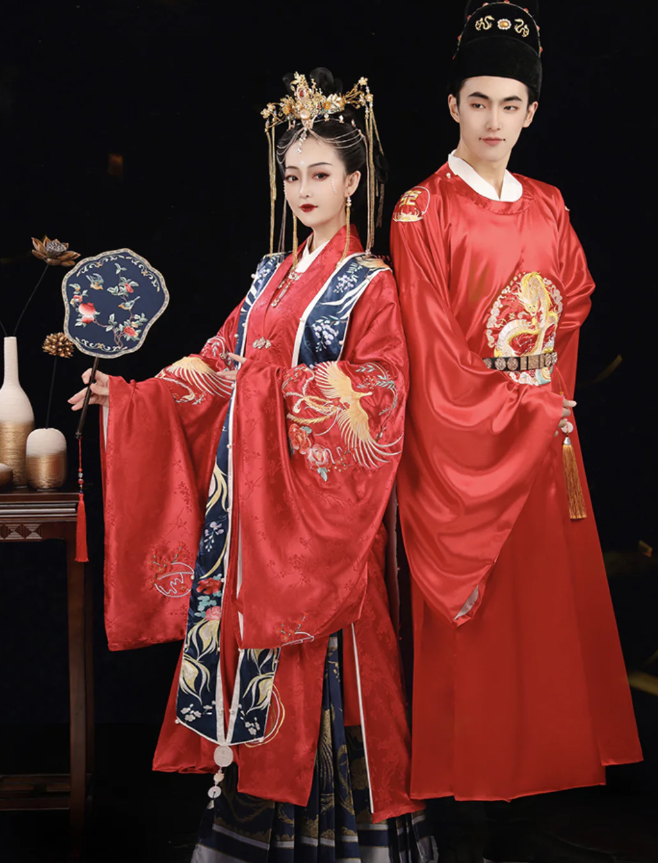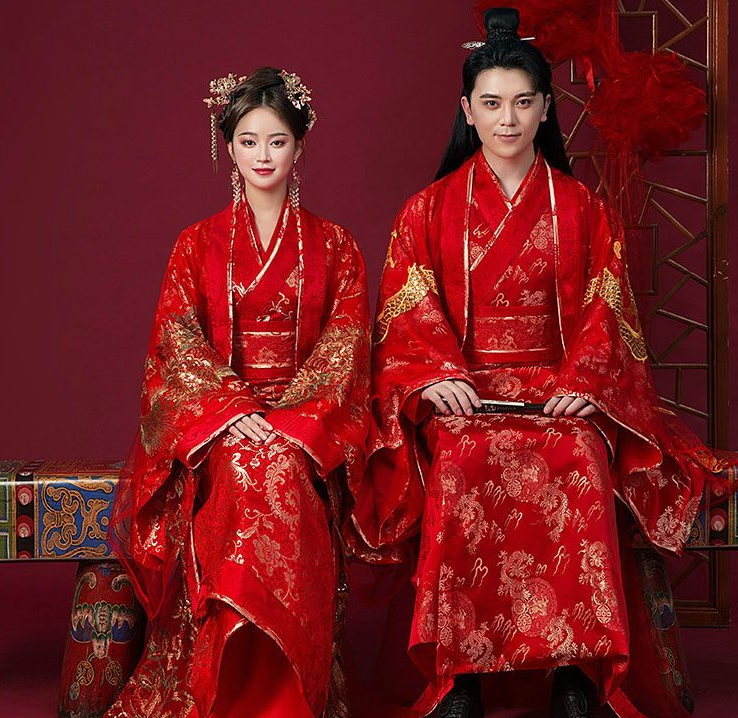Yes, many couples in modern times choose to wear Hanfu for their weddings to embrace and celebrate traditional Chinese culture.
The Resurgence of Hanfu in Modern Times
The modern era has witnessed the rebirth of traditional Chinese garments known as Hanfu. Once the everyday clothing of the Han Chinese people for millennia, Hanfu was almost forgotten in the 20th century. However, in recent times, young people, cultural enthusiasts, and fashion designers have been championing its revival. This section delves into the rise of the Hanfu Movement and examines the reasons behind Hanfu’s soaring popularity.

The Hanfu Movement
The Hanfu Movement originated in the early 2000s, with a mission to reintroduce traditional Han Chinese clothing into daily life. Fueled by a younger generation keen to reconnect with their cultural roots, the movement has garnered significant attention both domestically in China and globally.
Social media platforms have played an instrumental role in propelling the Hanfu Movement. Users on platforms like Weibo and TikTok often showcase themselves wearing Hanfu, participating in traditional Chinese activities, or recreating scenes from historical dramas. This digital exposure has made Hanfu more accessible and attractive, especially to the younger audience.
Factors Driving the Popularity of Hanfu
Several factors contribute to the rising popularity of Hanfu:
- Historical TV Dramas and Movies: Period dramas, showcasing rich Han Chinese history, have become extremely popular. These dramas, available on platforms like iQiyi and Tencent Video, spotlight the beauty and elegance of Hanfu, sparking interest among viewers.
- Cultural Renaissance: As China’s global influence grows, there’s a renewed sense of pride in Chinese history and culture. Embracing Hanfu becomes a way to connect with one’s heritage and demonstrate cultural pride.
- Fashion and Design: Many contemporary fashion designers are incorporating traditional Hanfu elements into their designs. These modern takes on Hanfu resonate with young people who are looking for a blend of tradition and style.
- Events and Gatherings: Across China, numerous Hanfu-themed events, conventions, and gatherings are organized. These events offer enthusiasts opportunities to display their outfits, exchange ideas, and immerse themselves in traditional Chinese activities.
Hanfu in Contemporary Weddings
With the cultural renaissance of Hanfu in modern times, its impact on contemporary weddings is profound. Today, many couples are choosing to integrate this traditional attire into their special day as a nod to their cultural heritage. This section explores the different types of Hanfu available for brides and grooms, the significance of wearing them on the wedding day, and ways to seamlessly incorporate Hanfu themes into modern wedding ceremonies.
Varieties of Hanfu for Brides and Grooms
Hanfu isn’t a one-size-fits-all kind of attire. Over the centuries, various styles have emerged, tailored to different dynasties, seasons, and occasions:
- Ruqun: A popular choice for brides, this is a type of Hanfu that consists of a blouse (Ru) and a skirt (Qun).
- Shenyi: A one-piece robe that wraps around the body, it’s often chosen by grooms for its elegant and dignified appearance.
- Quju: This robe with long, flowing sleeves is an iconic representation of Hanfu and is ideal for grand, traditional ceremonies.
- Banbi: A short blouse worn with skirts or trousers, often seen in summer weddings for its lightweight design.
The choice of Hanfu also depends on the region, personal preferences, and specific historical periods the couple wishes to emulate.
Significance and Symbolism of Hanfu in Weddings
Hanfu is more than just clothing; it’s steeped in symbolism. The colors, designs, and accessories often have profound meanings:
- Red: Traditionally, red is the color of luck, happiness, and prosperity. It’s no wonder then that many brides opt for vibrant red Hanfu.
- Phoenix and Dragon: These are auspicious symbols representing the balance of yin and yang. Often, wedding Hanfu will have these creatures embroidered, symbolizing a harmonious marriage.
- Patterns: Various patterns like peonies, chrysanthemums, and lotuses have symbolic meanings, ranging from wealth to purity.
Wearing Hanfu during a wedding is a reflection of respect for traditions, an acknowledgment of one’s roots, and a desire for blessings in the marital journey.
Incorporating Hanfu with Modern Wedding Themes
As couples today look for a blend of the old and new, Hanfu becomes a perfect element to infuse into contemporary wedding themes:
- Venue Decor: Combining Hanfu-inspired decor with modern aesthetics creates a unique ambiance. For instance, using traditional lanterns, scrolls, or calligraphy alongside modern lighting can produce a stunning effect.
- Photography: Modern wedding photoshoots can be enriched with scenes where the couple dons Hanfu, perhaps recreating classic paintings or historical dramas.
- Entertainment: Traditional Chinese performances, such as dances, songs, or poetry recitations, can be woven into the wedding program for an authentic experience.
Cultural Perspectives on Hanfu in Weddings
The integration of Hanfu into contemporary weddings not only represents an aesthetic choice but also carries with it deep cultural connotations. As the world becomes more globalized, discussions surrounding Hanfu in weddings become multi-faceted. This section explores the various viewpoints on Hanfu, from traditional stances to modern perspectives, regional variations, and the sensitive topic of cultural appropriation.
Traditional vs. Modern Views
For many older generations in China, Hanfu evokes nostalgia and reverence. It’s a tangible connection to a bygone era, reflecting historical authenticity:
- Traditionalists: They often advocate for Hanfu to be worn in its most authentic form, respecting age-old customs and rituals. To them, Hanfu is a living testament to China’s illustrious past.
- Modernists: The younger generation, while respecting tradition, tends to merge Hanfu with contemporary fashion sensibilities. They’re more open to experimenting with colors, designs, and even fusion styles. For instance, some may opt for a Hanfu-inspired gown or suit that combines both Eastern and Western elements.
The discourse between traditional and modern views underscores the dynamic nature of culture, showcasing how it evolves while still retaining its core essence.
Regional Differences in Hanfu Styles for Weddings
China’s vast landscape and diverse ethnic groups have given birth to distinct regional Hanfu styles:
- Northern Styles: Characterized by thicker fabrics and deeper hues, reflecting the colder climates of regions like Beijing and Shanxi.
- Southern Styles: Lighter materials with intricate embroidery are common in areas like Fujian and Guangdong.
- Western and Central China: Regions like Sichuan or Yunnan, with their rich ethnic diversity, have unique Hanfu styles influenced by local indigenous cultures.
Couples often choose a Hanfu style that resonates with their ancestral roots or the region they hail from, adding a personal touch to their wedding attire.
Addressing Cultural Appropriation Concerns
In an era of global exchange, elements of one culture often find their way into another. While this can foster mutual appreciation, it sometimes raises concerns about cultural appropriation:
- Appreciation vs. Appropriation: Wearing Hanf
- u or incorporating it into weddings outside of its cultural context should be done respectfully. It’s essential to understand the history and significance of the attire, rather than treating it as just another exotic fashion trend.
- Educating and Sharing: Those who genuinely appreciate Hanfu can take steps to educate others about its cultural significance. This can transform an act of mere appropriation into one of cultural exchange and understanding.
- Staying Informed: It’s crucial to stay informed and listen to voices from the Han Chinese community, understanding their perspectives on how Hanfu is represented and utilized globally.

Hanfu Wedding Accessories and Accompaniments
A Hanfu wedding ensemble isn’t complete without its suite of intricate accessories and accompaniments. These embellishments not only accentuate the attire but also hold symbolic meanings, deep-rooted in history and tradition. This section takes a closer look at the various adornments that often accompany Hanfu during weddings, from jewelry to footwear and thematic decor.
Traditional Jewelry and Hairpieces
Adorning oneself with jewelry has always been a crucial aspect of Han Chinese weddings:
- Hairpins and Headdresses: Often made of jade, gold, or silver, these intricate pieces might be adorned with pearls or gemstones. Common symbols like phoenixes or butterflies, which represent transformation and joy, might be incorporated. The way a hairpin is placed can also hold meaning, often denoting marital status or rank.
- Necklaces and Pendants: Jade, a stone of purity and protection, is frequently used in wedding jewelry. A common piece is the jade pendant, symbolizing luck and prosperity for the newlyweds.
- Earrings and Bracelets: Gold and pearls are standard materials, each carrying symbolic meanings like wealth, purity, and happiness.
Footwear and Other Accessories
While Hanfu itself is a showstopper, the ensemble wouldn’t be complete without its associated accessories:
- Shoes: Traditional Hanfu shoes, often referred to as “thousand-layer” shoes, are typically made of silk or brocade. Their upturned fronts, a distinct feature, are both aesthetically pleasing and functional, preventing the fabric from fraying.
- Fans: Hand-held fans made of silk, bamboo, or feathers might be used by both brides and grooms. They serve as a functional accessory for warmer days and as a prop for wedding photography or dances.
- Belts and Waist Accessories: Sashes, often embroidered with auspicious symbols or patterns, help secure the Hanfu in place. They also serve as an embellishment, accentuating the attire’s elegance.
Hanfu-Inspired Wedding Decor
To create a holistic Hanfu-themed wedding experience, many couples extend the aesthetic to their wedding decor:
- Table Settings: Traditional motifs, such as dragons, phoenixes, or chrysanthemums, might be woven into tablecloths, centerpieces, or dishware.
- Lanterns and Lighting: Paper lanterns inscribed with poetic verses or adorned with classic paintings can create a romantic ambiance.
- Venue Decor: Scrolls bearing calligraphy, traditional screens, or even bamboo installations can serve as backdrops or partitions, offering a seamless blend of history and elegance.
The Process of Choosing and Tailoring Hanfu for Weddings
Choosing the perfect Hanfu for a wedding is both an exciting and meticulous process. As with any significant attire decision, there are numerous factors to consider. From the selection of the ideal style to adding personal touches and ensuring the garment’s longevity, every step plays a crucial role in making the big day memorable. Let’s delve into the journey of selecting, tailoring, and caring for a Hanfu wedding attire.

Factors to Consider When Choosing a Hanfu
The ideal Hanfu reflects the wearer’s personality, cultural preferences, and the nature of the wedding ceremony:
- Historical Accuracy: Couples might want their Hanfu to represent a particular dynasty or period. Whether it’s the flowing elegance of the Tang Dynasty or the refined aesthetics of the Ming era, the historical context can significantly influence the design and silhouette.
- Material and Comfort: Silk, brocade, and linen are among the common fabric choices. The season of the wedding can guide the material selection—brocade for cooler months and lighter fabrics like silk or linen for summer ceremonies.
- Color Symbolism: In Chinese culture, colors hold significant meaning. Red, representing luck and joy, is a popular choice. However, gold signifies wealth and prosperity, while green, often linked with jade, symbolizes purity and virtue.
- Budget: As with any custom-made attire, the cost can vary widely. It’s essential to balance desires with practicality, choosing a Hanfu that aligns with the wedding budget.
Customizations and Personal Touches
Custom-tailoring a Hanfu ensures it aligns perfectly with individual preferences and body measurements:
- Embroidery: Personal motifs, perhaps symbolizing the couple’s journey or shared interests, can be embroidered onto the Hanfu. Classic symbols like the phoenix and dragon can also be incorporated, representing the balance of yin and yang.
- Accessories: Deciding on accompanying jewelry, hairpieces, or belts can provide an additional layer of personalization.
- Mixing Styles: Some couples opt to merge different regional or historical styles, crafting a unique blend that tells a personal story.
Caring for Hanfu Garments Post-Wedding
Preserving the beauty of a Hanfu goes beyond the wedding day:
- Storage: Hanfu garments, especially those made of delicate fabrics, should be stored away from direct sunlight. Using garment bags can protect them from dust and potential damage.
- Cleaning: Due to their intricate designs and delicate materials, it’s best to hand-wash or dry-clean Hanfu. Avoiding harsh chemicals and wringing will ensure the garment remains vibrant and intact.
- Repurposing and Reusing: While Hanfu is traditionally formal attire, many people find ways to incorporate them into other events or occasions.







